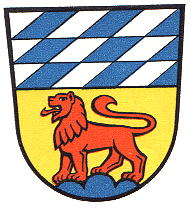Löwenstein: Difference between revisions
Knorrepoes (talk | contribs) m (Text replacement - "{{de1}}" to "{{de}}") |
Knorrepoes (talk | contribs) m (Text replacement - "|'''German'''↵| ↵I" to "|'''German''' | I") |
||
| Line 13: | Line 13: | ||
|- | |- | ||
|'''German''' | |'''German''' | ||
| | | In geteiltem Schild oben von Silber und Blau geweckt, unten in Gold auf blauem Dreiberg ein stehender roter Löwe. | ||
In geteiltem Schild oben von Silber und Blau geweckt, unten in Gold auf blauem Dreiberg ein stehender roter Löwe. | |||
|- | |- | ||
|'''English''' | |'''English''' | ||
Revision as of 11:00, 4 August 2023
LÖWENSTEIN
State : Baden-Württemberg
District (Kreis) : Heilbronn
Additions : 1975 Hösslinsülz
| German | In geteiltem Schild oben von Silber und Blau geweckt, unten in Gold auf blauem Dreiberg ein stehender roter Löwe. |
| English | blazon wanted |
Origin/meaning
Löwenstein received city rights in 1287, but there are no seals known until 1498. The seal already showed the present arms, which are a combination of the arms of the Wittelsbach family (see Bayern), and the lion of Calw.Until 1281 Löwenstein was a possession of a branch of the Counts of Calw, who named themselves after the castle Löwenstein. The arms were also appropriate as Löwenstein means lion-stone. In 1281 it became a possession of King Rudolf I, who gave it to his illegitimate son Albrecht. In 1441 it was bought by Prince Friedrich of the Pfalz, of the Wittelsbach dynasty. His grandson received in 1494 the title Count of Löwenstein and he combined the two arms to form the present arms.
Literature: Stadler, 1964-1971, 8 volumes.
This page is part of the German heraldry portal |
Heraldry of the World |
|
German heraldry:
|
Selected collector's items from Germany:
|


